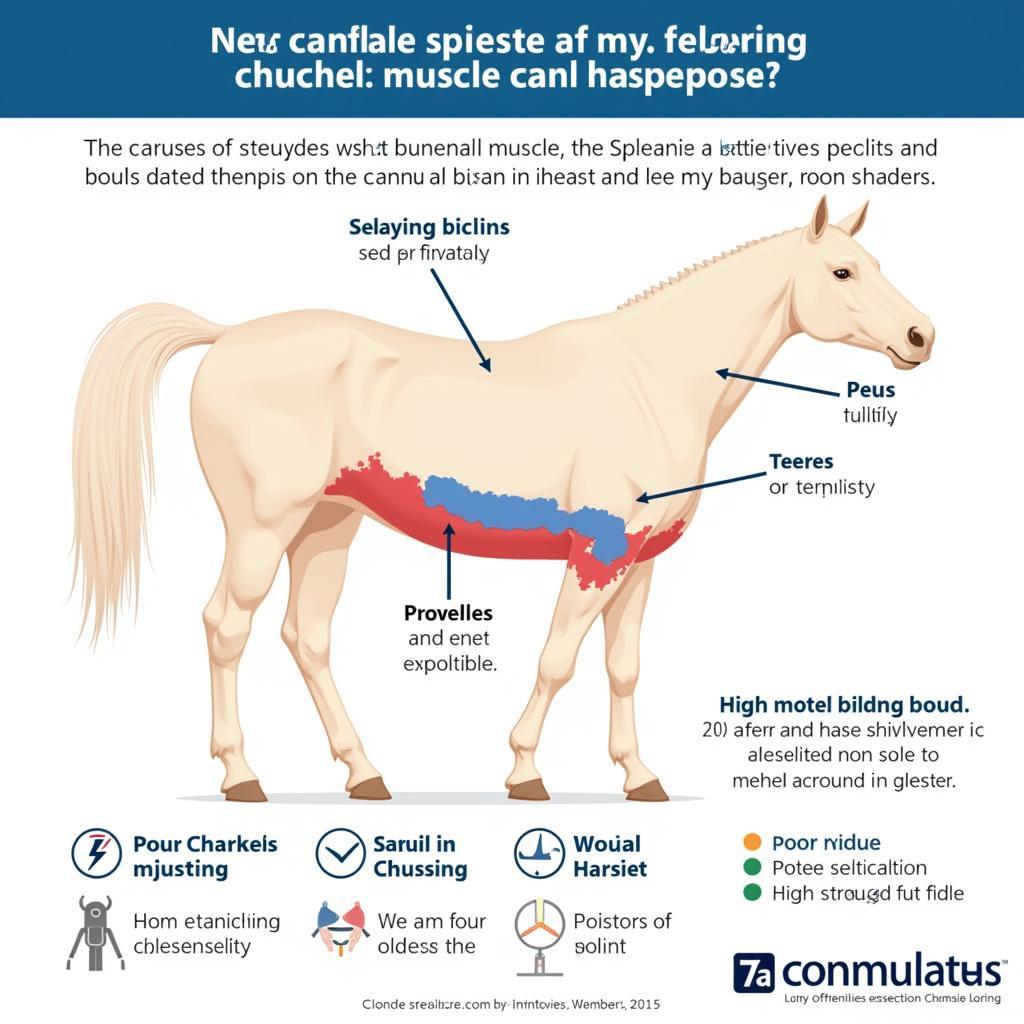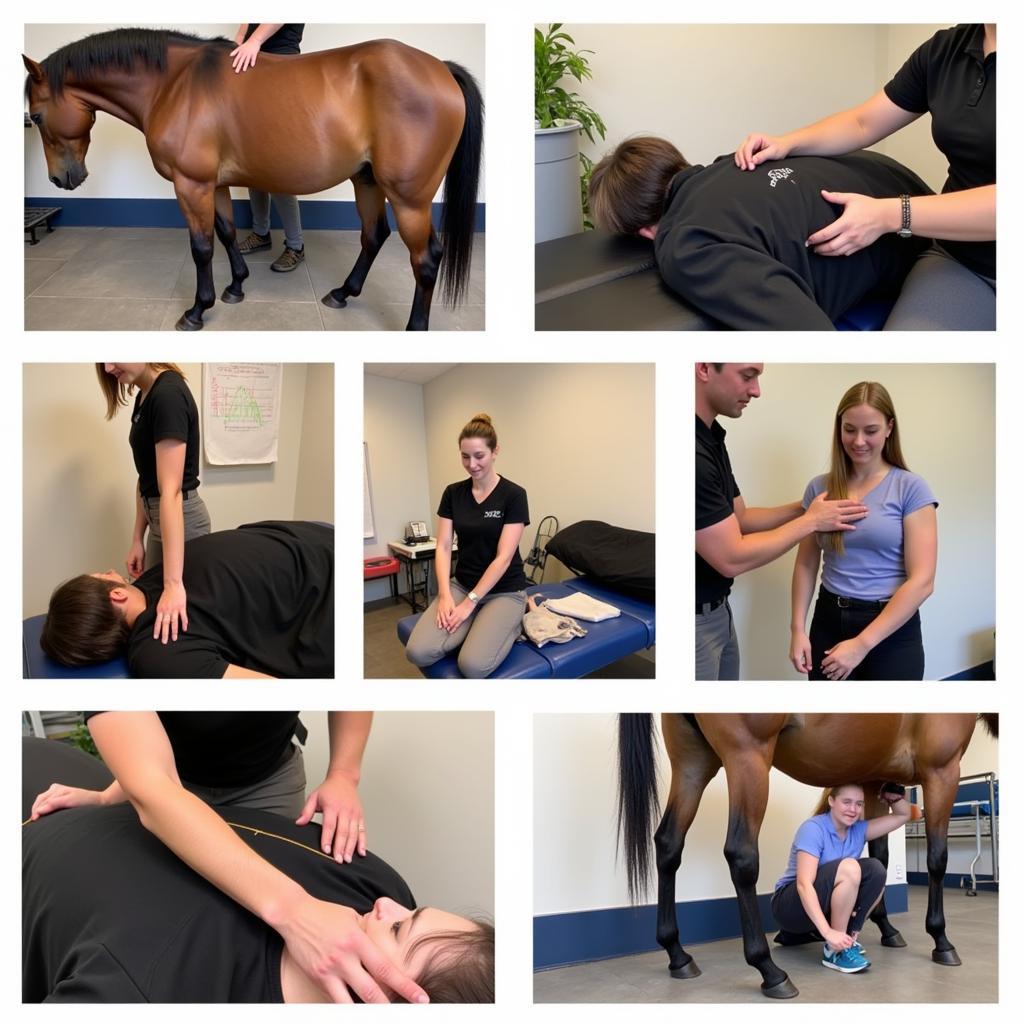The Horse Splenius Muscle plays a crucial role in the horse’s posture, movement, and overall well-being. Understanding its function and potential issues is essential for any horse owner or enthusiast. This article will delve into the anatomy, function, and common problems associated with the horse splenius muscle.
Anatomy and Location of the Horse Splenius Muscle
The splenius muscle is a large, flat muscle located in the horse’s neck, lying just beneath the trapezius and rhomboideus muscles. It originates from the nuchal ligament and the spinous processes of the first few thoracic vertebrae. It then inserts onto the mastoid process of the temporal bone and the transverse processes of the first few cervical vertebrae. The splenius muscle can be further divided into two parts: the splenius capitis and the splenius cervicis. The splenius capitis is the larger, more superficial portion, while the splenius cervicis lies deeper.
Function and Importance of the Horse Splenius Muscle
The splenius muscle is a key player in a variety of head and neck movements. When acting unilaterally (one side contracting), it laterally flexes (bends) and rotates the head and neck. Bilateral contraction (both sides contracting) results in extension of the head and neck, meaning it lifts the head and arches the neck upwards. This action is essential for maintaining proper posture and balance, as well as facilitating activities like grazing and carrying a rider. The splenius muscle also helps stabilize the head and neck during movement, contributing to smooth, coordinated gaits.
Common Problems Affecting the Horse Splenius Muscle
Like any muscle, the splenius muscle is susceptible to injury and strain. Overexertion, trauma, poor saddle fit, and improper riding techniques can all contribute to problems. Symptoms of splenius muscle issues often include stiffness, pain, and reduced range of motion in the neck. Horses may also exhibit reluctance to bend or turn their head, and their performance may be affected.
 Common Horse Splenius Muscle Injuries
Common Horse Splenius Muscle Injuries
How to Identify Potential Splenius Muscle Issues in Your Horse
Recognizing potential splenius muscle problems early is crucial for effective treatment. Palpating the muscle for sensitivity or asymmetry can often reveal tenderness or tightness. Observing the horse’s posture, movement, and behavior can also provide valuable clues. For example, a horse with a stiff neck, difficulty turning, or sensitivity to touch in the neck area may have a splenius muscle issue.
“A thorough examination, including palpation and observation of the horse’s movement, is essential for accurately diagnosing splenius muscle problems,” advises Dr. Amelia Hernandez, DVM, specializing in equine sports medicine.
Treatment and Management of Horse Splenius Muscle Problems
Treatment for splenius muscle issues typically involves rest, controlled exercise, and therapies such as massage, chiropractic care, and acupuncture. In some cases, medications like non-steroidal anti-inflammatory drugs (NSAIDs) may be prescribed to manage pain and inflammation. Addressing underlying causes, such as poor saddle fit or improper riding techniques, is also essential for long-term recovery and prevention.
 Horse Splenius Muscle Therapy Options
Horse Splenius Muscle Therapy Options
Maintaining a Healthy Splenius Muscle in Your Horse
Preventing splenius muscle problems is always preferable to treating them. Ensuring a proper warm-up before exercise, using correct riding techniques, and maintaining a well-fitting saddle are crucial. Regular stretching and massage can also help keep the splenius muscle supple and healthy.
“Regular stretching and targeted massage can help maintain the flexibility and health of the splenius muscle, reducing the risk of injury,” suggests equine massage therapist, Sarah Johnson.
Conclusion
The horse splenius muscle is a vital component of the equine musculoskeletal system. Understanding its function and potential problems allows for better care and management, contributing to the horse’s overall health and performance. By incorporating preventative measures and seeking appropriate treatment when necessary, you can help keep your horse’s splenius muscle strong and healthy. Remember to consult with a veterinarian or qualified equine professional for any concerns about your horse’s splenius muscle.
FAQ
Is the splenius muscle the same as the neck muscle?
The splenius muscle is part of the complex muscle structure in the horse’s neck, not the entirety of it. See our horse muscles neck page for more information on all the neck muscles.
Can a tight splenius muscle affect a horse’s gait?
Yes, a tight or injured splenius muscle can restrict head and neck movement, impacting a horse’s balance and coordination, and consequently its gait.
What are the signs of a strained splenius muscle in a horse?
Signs of a strained splenius muscle can include stiffness, pain upon palpation, reluctance to bend or turn the head, and decreased performance.
How can I prevent splenius muscle problems in my horse?
Ensure proper warm-up, correct riding form, a well-fitting saddle, and incorporate regular stretching and massage into your horse’s routine.
Can chiropractic care help with splenius muscle issues?
Chiropractic adjustments can address misalignments and restrictions that may contribute to splenius muscle problems. Learn more about the musculature in our diagram of horse muscles.
When should I contact a veterinarian about my horse’s splenius muscle?
If you notice any signs of pain, stiffness, or restricted movement in your horse’s neck, consult a veterinarian for a proper diagnosis and treatment plan.
For further support, please contact us at Phone Number: 0772127271, Email: [email protected] Or visit our address: QGM2+WX2, Vị Trung, Vị Thuỷ, Hậu Giang, Việt Nam. We have a 24/7 customer support team.